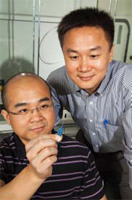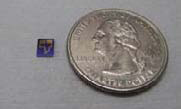Sensing The Future: Water Technology's 'Holy Grail'

By Kevin Westerling,
@KevinOnWater
Real-time contaminant detection, featuring a network of sensors throughout the distribution network, is poised to revolutionize the water industry.
Scientists are scrambling to beat each other to the punch, and instrumentation companies are monitoring (no pun intended) the competition closely and aggressively. At stake is the inside track on a technology that promises to change the course of utility operations, and perhaps much more.
 The breakthrough discovery is the real-time detection of bacteria and other constituents in water, with the added capability of instantly communicating the data to a central location. For drinking water utilities, it’s the arrival of “intelligent water distribution,” utilizing a network of these remote-communication, real-time sensors to detect contaminants throughout the distribution system. Though the technology is not yet mature, these sensors are most definitely coming — and their impact will be profound.
The breakthrough discovery is the real-time detection of bacteria and other constituents in water, with the added capability of instantly communicating the data to a central location. For drinking water utilities, it’s the arrival of “intelligent water distribution,” utilizing a network of these remote-communication, real-time sensors to detect contaminants throughout the distribution system. Though the technology is not yet mature, these sensors are most definitely coming — and their impact will be profound.
A New World Of Capabilities
“You can’t control what you can’t measure” is a broadly applicable adage, and particularly relevant to water quality. Imagine what the control operators would (or will) gain by being able to remotely see contaminants of any type, anywhere in the pipeline — from plant to tap — in real time. No longer would samples need to be gathered in the field and taken back to the lab for testing. When it comes to bacteria and viruses, the time lag between contamination and discovery that currently exists would be essentially eliminated, meaning less community exposure and illness. The benefits these enhanced capabilities bring to public health and utility operations are easy to recognize.
 But what else does real-time sensing bring to the table? The possibilities are virtually limitless.
But what else does real-time sensing bring to the table? The possibilities are virtually limitless.
Because the sensors can be engineered on an ad hoc basis — that is, customized for specific needs and constituents — the technology has the potential to be utilized for almost any application involving liquids and to measure just about anything. The industrial and wastewater applications are further down the line, however, as the sensors are engineered to become more robust. Initially the technology will be used to detect and communicate the presence of drinking water contaminants, specifically E. coli and heavy metals (e.g. arsenic, cadmium, chromium, lead, and selenium).
Research And Development
As you read this, Dr. Junhong Chen is working feverishly. So, too, are his competitors. The goal is to be the first to market with this new sensor technology, and the market won’t respond unless the price is reasonable. According to Chen, director of the U.S. National Science Foundation Industry & University Cooperative Research Center (I/UCRC) on Water Equipment and Policy at the University of Wisconsin-Milwaukee (UWM), that price is $10 per sensor. A second challenge is to ensure the resiliency of the units in the field, since the very idea of the technology is to “set it and forget it” (for at least a year, and then only to change the battery), thereby dispensing with the typical O&M effort of sending personnel to multiple sampling sites. The third obstacle is miniaturization of the sensors, so that many individualized contaminant detectors can be housed in a single probe.
“In the size of a fingernail, we can potentially integrate hundreds of sensors,” said Chen, who described the patent-pending technology as the “Holy Grail” for the water industry.
“We’ll have sensors attached to the filter cartridge, to the pump, and to the water meter so that — in addition to whatever conventional functionality the equipment is providing — we can see contamination levels,” Chen predicted. “That’s the future.”
The rapidly developing technology is being realized due to the development of graphene, which earned the 2010 Nobel Prize in Physics for the University of Manchester researchers who discovered it. At just one atom thick, graphene is “not only the thinnest [material] ever but also the strongest,” stated the Royal Swedish Academy of Sciences, presenters of the Nobel. The Academy also noted that graphene conducts heat better than all known materials and conducts electricity at least as well as copper. Graphene’s potential for electronics was recognized from the start, as it was predicted to make transistors that are significantly faster than today’s silicon transistors.
Using this knowledge as foundation, inventors at the Water Equipment and Policy Research Center (WEP) — established in 2010, the same year graphene earned the Nobel — set out to create a real-time, “intelligent” sensor for water/wastewater quality and control. Dr. Junhong Chen is leading the research, working with his colleagues in the WEP network. Based in Milwaukee, WEP includes two universities (UWM and Marquette), as well as seven industry members, six of businesses (A.O. Smith, Badger Meter, Baker Manufacturing, Pentair, and Marmon Water), a consulting company (Gannett Fleming), and the local municipality (Milwaukee Metropolitan Sewage District).
The result is what Chen called a “revolution for water-related equipment” — graphene oxide (GO) field-effect transistor (FET) sensors. According to UWM, the new sensors offer the following advantages over current technology:
- Faster — Rapid response for real-time monitoring
- Highly sensitive — Detection of E. coli 0157:H7 concentrations down to 1 CFU (colony-forming unit) per mL
- Scalable — Fabrication can be scaled up with good reproducibility/high electrical stability
- Inexpensive — Materials for fabrication are relatively inexpensive
- In situ detection — Sensors can be placed directly in the water system.
“You can stick the sensor onto anything to tell you what’s in the water,” Chen projected.
Right now, the technology has been proven for E. coli, which is first on the docket for real-world application. Chen estimates that it will be a year or more before reaching that point, with sensors for the detection of heavy metal ions to follow. Now that the science has been established, however, realizing this soon-to-be transformative technology is inevitable. The progress could be hastened by additional funding — the National Science Foundation and the EPA, for instance, have programs to support innovation — and there is surely a host of competitors worldwide striving toward the same goal.
“I would say everybody would be willing to invest in this technology,” said Chen.
Market Impact
Drinking water utilities may be the first to see benefit from real-time sensors, but the technology is destined to have far-reaching effects. The food and beverage industries, with so many of their products containing water, would be obvious beneficiaries. Applications in the medical field have the capacity to improve care and save lives (the technology can be adapted to any liquid — even within the human body). Real-time sensing will enable pharmaceuticals and personal care products (PPCPs), which release a vast array of hard-to-detect “emerging contaminants” into the environment, to be spotted and controlled much more easily. Wastewater treatment facilities will be able to monitor the effectiveness of their filtration and treatment systems by detecting contaminant breakthroughs anywhere in the system.
Naturally, the companies who produce monitoring and instrumentation equipment are among those who see great potential. Fred Begale, VP of engineering for Badger Meter, called real-time sensing “the next paradigm” for water technology.
“First it was metering, 50+ years ago, and then communications came along about 15 years ago,” said Begale. “In the last few years, we’ve seen the advancement of analytics-based software such as district metering and leak detection. The next stage will be real-time sensing mechanisms to maintain and support all those elements more precisely.”
As a WEP member, Badger Meter shares the intellectual property rights of the technology being developed, so it may have a leg up on the competition. “If I could provide automation that also gives utilities insight into their water quality, that’s a big deal,” Begale explained.
“It doesn’t mean that other companies aren’t looking at this as well and working on it in their own space,” he added. Truly transcendent technologies, after all, are nearly impossible to contain.
Once the cat is out of the bag, so to speak, the technology — and the world of capabilities it enables — will surely be shared by many, and to the benefit of nearly every citizen. While the revolution isn’t upon us quite yet, the evolution that precedes it is well underway.
